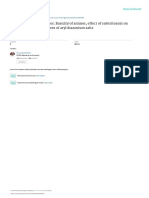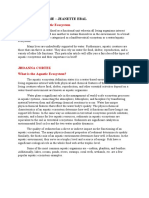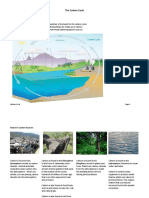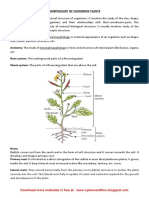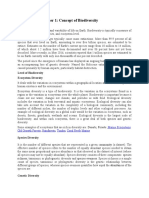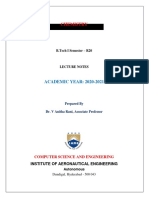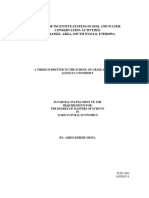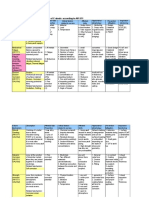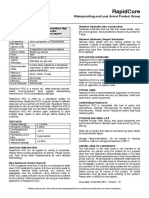Natural Resources Notes
Natural Resources Notes
Uploaded by
Himanish KoyalkarCopyright:
Available Formats
Natural Resources Notes
Natural Resources Notes
Uploaded by
Himanish KoyalkarOriginal Title
Copyright
Available Formats
Share this document
Did you find this document useful?
Is this content inappropriate?
Copyright:
Available Formats
Natural Resources Notes
Natural Resources Notes
Uploaded by
Himanish KoyalkarCopyright:
Available Formats
INSTITUTE OF AERONAUTICAL ENGINEERING
(Autonomous)
Dundigal, Hyderabad -500 043
UNIT-V
Natural Resources and Environmental Pollution
I.Classification of Resources
Resources can be classified in the following ways:
(A) Living and non living resources
Living resources : These are biological resources that are used by human beings Examples:
forests, croplands, animal resources.
Non-living resources: These are not derived from biological materials
Examples: soil, land, water
(B) Renewable and non renewable resources
Renewable resources: These are in exhaustive and can be regenerated within a given span of
time
Examples: forests, wildlife, wind energy, biomass energy, tidal energy,hydro power etc
Solar energy is also a renewable form of energy as it is an inexhaustible source of energy.
Non-renewable resources : The resource which cannot be regenerated in a time span
Examples: Fossil fuels like coal, petroleum, minerals etc.
Once we exhaust these reserves, the same cannot be replenished.
Even our renewable resources can become non-renewable if we exploit them to such extent
that their rate of consumption exceed their rate of consumption exceeds their rate of
regeneration.
Example: if species is exploited so much that its population size declines below the threshold
level then it is not able to sustain itself and gradually the species becomes endangered or
extinct.
IARE NATURAL RESOURCES Page1
It is very important to protect and conserve our natural resources and use them in judicious
manner so that we do not exhaust them.It does not mean that we should stop using most of the
natural resources.
II.Water Resources:
Water is an indispensable natural resource on this earth on which all life depends. About 97%
of the earth s surface is covered by water and most of the animals and plants have 60-65%
water in their body.
Water : A Precious Natural Resource:
Although water is very abundant on this earth , yet it is very precious.
Out of the total water reserves of the world, about 97% is salty water and only 3% is
readily available to us in the form of ground water and surface water.
Even this small fraction of fresh water is not available to us as most of it is locked up in
polar ice caps and just 0.003% is readily available to us in the form of groundwater and
surface water.
Overuse of groundwater for drinking, irrigation and domestic purposes has resulted in
rapid depletion of groundwater in various regions leading to lowering of water table and
drying of wells.
Pollution of many of the groundwater aquifers has made many of these wells unfit for
consumption.
Rivers and streams have long been used for discharging the wastes.
Most of the civilizations have grown and flourished on the banks of rivers, but
unfortunately, growth in turn, has been responsible for pollution of the rivers
As per the United Nations estimates (2002), at least 101 billion people do not even have
access to safe drinking water and 2.4 billion do not have adequate sanitation facilities.
Increasing population and expanding development would further increase3 the demands
for water
It is estimated that by 2024, two-thirds of the world population would be suffering from
acute water shortage.
IARE NATURAL RESOURCES Page2
Water _A Unique Resource
1. Water is characterized by certain unique features which make it marvelous
resource
2. It exists as a liquid over a wide range of temperature i.e. from 00 c to 1000c
3. It has the highest specific heat , due to which it warms up and cools down very
slowly without causing shocks of temperature jerks to aquatic life.
4. It has a high latent heat of vaporization .Hence; it takes a huge amount of energy
for getting vaporized. That’s why it produces a cooling effect as it evaporates.
5. It is an excellent solvent for several nutrients. Thus, it can serve as very good
carrier of nutrients, including oxygen, which are essential for life. But , it can also
dissolve various pollutants and become a carrier of pathogenic microorganisms.
6. Due to high surface tension and cohesion it can easily rise through great heights
through the trunk even in the tallest of the trees like sequoia.
7. It has anomalous expansion behavior i.e as it freezes; it expands instead of
contracting and thus becomes lighter. It is because of this property that even in
extreme cold, the lakes freeze only on the surface. Being lighter the ice keeps
floating, where as the bottom waters remain at a higher temperature and where as
the bottom waters remain at a higher temperature and therefore, can sustain
aquatic organisms even in extreme cold.
Hydrological Cycle
The water we use keeps on cycling endlessly through the environment, which we
call as hydrological cycle.
1. The water from various moist surfaces evaporates and falls again on the earth in
the form of rain or snow and passes through living organisms and ultimately
returns to the oceans.
2. Every year about 104 inch thick layer of water evaporates from the oceans, more
than 90% of which returns to the oceans through hydrological cycle.
IARE NATURAL RESOURCES Page3
3. Solar energy drives the water cycle by evaporating it from various water bodies,
which subsequently return through rainfall or snow.
4. Plants too play a very important role by absorbing the ground water from the soil
and releasing it into the atmosphere by the process of transpiration.
5. Global distribution of water resources is quite uneven depending upon several
geographic factors.
6. Tropical rain forest receive maximum rainfall while the major world deserts occur
in zones of dry, descending air(20-40 N and S) and receive very little rainfall.
Water Use And Over-Exploitation
Due to its unique properties water is of multiple uses for all living organisms.
Water is absolutely essential for life.
Uptake of nutrients, their distribution in the body, regulation of temperature, and
removal of wastes are all mediated through water.
Human beings depend on water for almost every developmental activity.
Water is used for drinking, irrigation, and transportation, washing and waste
disposal for industries and used as a coolant for thermal power plants.
Water shapes the earth‘s surface and regulates our climate.
Water use by humans is of two types:
(i )Water withdrawl : Taking water from ground water or surface water resource
(ii)Water consumption: The water which is taken up but not returned for reuse.
On a global average 70 percent of the water withdrawn is used for agriculture. In India,
we use 93% of water in agricultural sector while in a country like Kuwait, which is water
–poor ,only 4% is used in industry, which again varies from a high of 70% in European
countries to as 5% in less developed countries.
In USA, an average family consumes more than 1000m3 of water per year, which is
many times more than that in most developing countries.
IARE NATURAL RESOURCES Page4
Ground water
About 9.86% of the total fresh water resources is in the form of groundwater and it is
about 35-50 times that of surface water supplies.
Till some time back groundwater was considered to be very pure.
However, of late, even groundwater aquifers have been found to be
contaminated by leachates from sanitary landfills etc.
A layer of sediment or rock that is highly permeable and contains water
is called an aquifer.
Layers of sand and gravel are good aquifers while clay and crystalline
rocks are not since they have low permeability.
Aquifers may be of two types
(i)Unconfined aquifers : which are overlaid by permeable earth
materials and they are recharged by water seeping down from above in
the form of rainfall and snow melt.
(ii)Confined aquifers : which are sandwiched between two impermeable
layers of rock or sediments and are recharged only in those areas where
the aquifer intersects the land surface.
Sometimes the recharged area is hundreds of kilometers away from the
location of the well.
Groundwater is not static, it mover, though at a very slow rate of about a
meter or so in a year.
Effects of groundwater usage
(i)Subsidence:
When groundwater withdrawal is more than its recharge rate, the
sediments in the aquifer get compacted, a phenomenon known as ground
subsidence.
Huge economic losses may occur due to this phenomenon because it
results in the sinking of overlying land surface.
The common problems associated with it include structural damage in
buildings, fracture in pipes, reversing the flow of sewers and canals and
tidal flooding.
IARE NATURAL RESOURCES Page5
(ii)Lowering of water table :
Mining of groundwater is done extensively in arid and semi-arid regions
for irrigating crop fields.
However , it is not advisable to do excessive mining as it would cause a
sharp decline in future agricultural production, due to lowering of water
table.
(iii)Lowering of water table :
Mining of groundwater is done extensively in arid and semi-arid regions
for irrigation crop fields.
However, it is not advisable to do excessive mining as it would cause a
sharp decline in future agricultural production, due to lowering of water
table.
Water logging:
When excessive irrigation is done with brackish water it raises the water
table gradually leading to water-logging and salinity problems
Surface Water
The water coming through precipitation when does not percolate down
into the ground or does not return ot the atmosphere as evaporation or
transpiration loss, assumes the form of streams, lakes, ponds, wetlands or
artificial reservoirs known as surface water.
The surface water is largely used for irrigation, industrial use, public
water supply, navigation etc.
Floods:
An overflow of water, whenever the magnitude of water flow exceeds the carrying
capacity of channel within its banks is called as flood.
Causes of Floods:
Various causes of floods are..
Heavy rainfall and sudden melting of ice.
Insufficient water channel capacity of rivers.
Construction of buildings, roads which prevents infiltration of water into soil.
IARE NATURAL RESOURCES Page6
Deforestation, overgrazing and mining increases the runoff from rains and hence
increases the flood level.
Soil erosion and loss of vegetation would lead to flooding due to heavy rain.
Effects of Floods
Flood water brings various diseases, flood kills human lives.
Aquatic and wildlife habitats are destroyed by floods. This leads to loss of bio-
diversity due to migration of wildlife species to the adjoining areas.
Flood causes economic loss, loss of crops, loss of livestock and property damage.
Drainage system and public transport systems gets disrupted causing
inconvenience and discomfort to common public.
Flood can cause slitting of dams, damage of bridges and damage of hydropower
plants.
Agriculture produce can be submerged under flood water causing financial loss to
community.
Flood Management
Construction of dams and reservoirs is an effective method of controlling floods.
Advance metrological information can give enough time to active disaster
management systems.
Hydro engineering operations in flood affected areas for proper diversion of flood
water.
Construction of floodways and reserving green zone on the river banks.
Drought
Drought is scarcity of water. Drought occurs due to inadequate rainfall, late arrival
of rains overutilization of ground water.
The condition of dryness for prolonged period is called drought due to drop of
average rainfall. Drought cause famine and starvation of human & animal
population of region concerned. Drought is the most serious physical hazard to
agriculture.
IARE NATURAL RESOURCES Page7
Shortage of water for even the basic needs is the main problem in the drought
areas.
Shallow rooted plants don’t grow. Infiltration wells, construction of dams, water
sheds are being taken up in drought prone areas.
Clouds seeding techniques, artificial rains etc., are to be implemented.
Drought – damages:
Direct
loss of income
social dislocation
famine/malnutrition/death
Indirect
loss of rural and urban revenues
fire hazard, loss of water access
Benefits of Dams
River valley projects with big dams have usually been considered to play a key role in
the development process due to their multiple uses.
India has the distinction of having the largest number of river-valley projects.
The tribals living in the area pin big hopes on these projects as they aim at providing
employment and raising the standard and quality of life.
The dams have tremendous potential for economic upliftment and growth.
They can help in checking floods and famines, generate electricity and reduce water and
power shortage, provide irrigation water to lower areas, provide drinking water in remote
areas and promote navigation, fishery etc.
Environmental Problems Due To Dams
The impacts can be at the upstream as well as downstream levels.
(A) The upstream problems include the following.
IARE NATURAL RESOURCES Page8
(a) Displacement of tribal people
(b) Loss of forests, flora and fauna
(c) Changes in fisheries and the spawning grounds
(d) Siltation and sedimentation of reservoirs
(e) Loss of non-forest land
(f) Stagnation and water logging near reservoir
(g) Breeding of vectors and spread of vector-borne diseases
(h) Reservoir induced seismicity (RIS) causing earthquakes
(i) Growth of aquatic weeds.
(B) The downstream impacts include the following:
(a) Water logging and salinity due to over irrigation
(b) Micro-climatic changes
(c) Reduced water flow and silt deposition in river
(d) Flash floods
(e) Salt water intrusion at river mouth
(f) Loss of land fertility along the river since the sediments carrying
Nutrients get deposited in the reservoir
(g) Outbreak of vector-borne diseases like malaria
Thus, although dams are built to serve the society with multiple uses, but it has
several serious side-effects. That is why now there is a shift towards construction of
small dams or mini-hydel projects
Land Resources:-
Land is the major part of the lithosphere.
Land plays a major role for growth of crops, vegetation, forests etc.,
Soils are formed due to disintegration of rocks by various physical processes like
change in temperature, pressure, blowing wind and flow of water.
The top layer of soil consists of mixtures of Humus (dead leaves & plants), some
of the living organisms and Inorganic components which supply nutrients to the
soil. Soil fertility depends on inorganic matter, organic matter, water, air and a
variety of micro-organisms viz., bacteria, fungi, which help in the decomposition
of organic matter and regeneration of nutrients.
Land is a physical entity which includes natural resources like forest, water,
minerals, food, energy and etc.
IARE NATURAL RESOURCES Page9
Land is the biggest resources for biotic community to reproduce, live, sustain,
grow, exploit and many life supporting activities.
It is equally important to protect forests, grasslands, wetlands, mountains, coasts
etc. in order to presence biodiversity.
Soil composition:
Soil fertility depends four major components of soil are mineral materials,
organic matter, water and air.
• Mineral materials:
• Mineral materials elements (Si, Fe, O, Mg, Al, Ca, Na, K and etc..), quartz
(SiO2), iron-silicates and aluminum silicates.
• Organic matter:
• Came from the residues of plants and animals. Organic matter can be crop
residues, grasses, bacteria, fungi, other microorganisms and animal wastes.
Soil composition:
• Water:
• It is a good solvent for many nutrients which move into plant roots.
• Air:
• Air encourages optimum rate of the essential metabolic process of various
organisms.
• Land degradation:
• Any change in land that reduces its quality and productivity is referred land
degradation.
• The land degradation results in deterioration of soil or loss of fertility of the soil.
Soil Erosion:
The top layer of the earth is called as soil.
IARE NATURAL RESOURCES Page10
• Soil erosion occurs due to deforestation, overgrazing, industrialization;
desertification etc.
• Soil is not immune to erosion, and like rocks along a coastline, soil can erode due
to the effects of forces, such as water, wind and farming practices.
• Soil is naturally created when small pieces of weathered rocks and minerals mix
with organic materials from decaying plants and animals.
• Soil creation is a slow process, taking many years. However, the soil that is
created is constantly subjected to natural and manmade forces that disrupt it.
Soil Erosion:
• Soil erosion is defined as the wearing away of topsoil.
• Topsoil is the top layer of soil and is the most fertile because it contains the most
organic, nutrient-rich materials.
• Therefore, this is the layer that farmers want to protect for growing their crops
and ranchers want to protect for growing grasses for their cattle to graze on.
• One of the main causes of soil erosion is water erosion, which is the loss of
topsoil due to water.
• Raindrops fall directly on topsoil.
• The impact of the raindrops loosens the material bonding it together, allowing
small fragments to detach.
• If the rainfall continues, water gathers on the ground, causing water flow on the
land surface, known as surface water runoff.
• This runoff carries the detached soil materials away and deposits them
elsewhere.
• There are some conditions that can accentuate surface water runoff and therefore
soil erosion.
• For example, if the land is sloped, there is a greater potential for soil erosion due
IARE NATURAL RESOURCES Page11
to the simple fact that gravity pulls the water and soil materials down the slope.
• Also, water will have an easier time running across the surface, carrying topsoil
with it.
Types of Soil erosion:
There are different types of soil erosion caused by water.
1. Sheet erosion
2. Slip erosion
3. Rill erosion
4. Gully erosion
Sheet erosion:
• Sheet erosion is an erosion that occurs fairly evenly over an area.
• As raindrops loosen soil, the surface water runoff can transport topsoil in a
uniform fashion, almost like a bed sheet sliding off of a bed.
• This can be so subtle that it might not even be noticed until much of the valuable,
nutrient-rich topsoil has already been washed away.
• If a farmer heads out to his field and sees an accumulation of soil and crop
residue at one end of his field, he should be worried about sheet erosion.
Slip erosion:
• This occurs due to heavy rainfall on slopes of hills and mountains.
Rill Erosion:
• Rill erosion is erosion that results in small, short-lived and well-defined streams.
• When rainfall does not soak into the soil, it can gather on the surface and run
downhill, forming small channels of water called rills.
IARE NATURAL RESOURCES Page12
• You can use this fact as a memory jogger if you remember that 'a little rill will
run downhill.
• ' A rill will dry up after the rainfall, but you may still see the stream bed that was
created by the temporary stream.
Gully Erosion:
• Gully erosion can be thought of as advanced rill erosion.
• In fact, if rills are not addressed, they will grow into larger gullies.
• Gully erosion can spell big problems for farmers because the affected land is not
able to be used for growing crops, and the big ditches create a hazard for the
farmer driving his farm machinery over the fields.
Causes for soil erosion:
• Deforestation: Mining, industrial, urban development etc causes deforestation
and leads to exposure of the land to wind and rains causing soil erosion. Cutting
trees leads to deforestation which in turn loss of organic matter in the soils.
• Overgrazing: When sufficient amount of grass is available for the organisms
usually the entire land/area may be subjected to exhaust and the land is exposed
without grass and ultimately the land expose to wind/rain causing soil erosion.
• Industrialization: Different processes carried out by industries and mining
operations cause soil pollution which leads to degradation of land.
• Desertification: The process of conversion of productive lands to unproductive
lands is called desertification.
Land degradation :
• Land degradation can be defined as any change in the land that alter its
conditions or reduces its quality.
Causes of Land degradation:
• Land degradation occurs due to both natural disasters like volcanic eruptions,
IARE NATURAL RESOURCES Page13
earthquakes, heavy rains, fire etc or human induced activities.
• The other causes of land degradation consists of wind blow, salinity of water,
water logging, soil acidity, loss of flora and fauna.
• Desertification is land degradation occurring in the arid, semi-arid regions of the
world.
• These dry lands cover about 40% of the earth’s surface and puts at risk more than
1 billion people who are dependent on these lands for survival.
• Land clearing and deforestation, Mining activity in forest areas, urban
conversion, bringing more land under cultivation, soil pollution , loss of organic
matter in the soils, alkalinization of soils, salinity of water etc leads to land
degradation.
• Severe land degradation affects in decreasing the mineral wealth and economic
development of nations.
• The methods that are followed for the prevention of land degradation are called
soil conservation methods
Reasons of land degradation:
• Population: With rapid growth in population more land is needed for producing
food, wood, fiber and fuel. Thus land resources are over utilized causing land
degradation.
• Urbanization: Because of population urbanization also increases. The
urbanization leads to deforestation which effects millions of plants and animal
species.
• Fertilizers and pesticides: To improve the agricultural productivity, fertilizers
and pesticides are used on large scale. The excess use of fertilizers and pesticides
leads to pollution of land and water. Thus land (soil) gets degraded further.
• Damage to top soil: Increased food production causing damage of top soil
through nutrient depletion.
IARE NATURAL RESOURCES Page14
• Water logging: The land productivity reduces because of rise in ground water
close to or above the soil surface cause water-logging. This is caused because of
incorrect irrigation management.
• Salination: The land degradation is caused by increases of salt in the soil or
intrusion of sea water into coastal land.
Renewable Energy:
• Those sources of energy which are inexhaustible and can be regenerated again and
again are called renewable sources of energy.
• Eg: Solar energy, wind energy, Ocean energy (Tidal and Ocean thermal energy-
OTE), Geothermal energy, Biomass energy, Hydropower energy, etc.,
Non-renewable Energy:
• Those sources of energy which are exhaustible and can’t be regenerated again and
again are called non-renewable sources of energy.
• Eg: Coal energy, Natural Gas energy (CH4), Liquefied Petroleum Gas – LPG
(Ethane, n-butane, iso-butane, butylenes and propane) etc.
Solar Energy:
Our sun is a natural nuclear reactor. It releases tiny packets of energy called photons,
which travel the 93 million miles from the sun to Earth in about 8.5 minutes.
step 1: sunlight activates the panels.
• Each individual panel is constructed of a layer of silicon cells, a metal frame, a
glass casing surrounded by a special film, and wiring. For maximum effect, the
panels are grouped together into “arrays” (an ordered series) and placed on
rooftops or in large outdoor spaces. The solar cells, which are also referred to
as photovoltaic cells, absorb sunlight during daylight hours.
step 2: the cells produce electrical current
• Within each solar cell is a thin semiconductor wafer made from two layers of
silicon. One layer is positively charged, and the other negatively charged, forming
an electric field. When light energy from the sun strikes a photovoltaic solar cell, it
energizes the cell and causes electrons to ‘come loose’ from atoms within the
semiconductor wafer. Those loose electrons are set into motion by the electric
field surrounding the wafer, and this motion creates an electrical current.
IARE NATURAL RESOURCES Page15
step 3: the electrical energy is converted
• solar panels working efficiently to transform sunlight into electricity, but the
electricity generated is called direct current (or DC) electricity, which is not the
type of electricity that powers most homes, which is alternating current (or AC)
electricity. Fortunately, DC electricity can easily be changed into AC electricity by
a gadget called an inverter.
step 4: the converted electricity powers your home
• Once the solar energy has been converted from DC to AC electricity, it runs
through your electrical panel and is distributed within the home to power your
appliances
IARE NATURAL RESOURCES Page16
step 3: the electrical energy is converted
• solar panels working efficiently to transform sunlight into electricity, but the
electricity generated is called direct current (or DC) electricity, which is not the
type of electricity that powers most homes, which is alternating current (or AC)
electricity. Fortunately, DC electricity can easily be changed into AC electricity by
a gadget called an inverter.
step 4: the converted electricity powers your home
• Once the solar energy has been converted from DC to AC electricity, it runs
through your electrical panel and is distributed within the home to power your
appliances
IARE NATURAL RESOURCES Page17
Advantages:
1. Available for free of cost.
2. Absorbent plates on a roof can heat liquid in tubes that supply a house with hot
water.
3. solar cells generate energy for far-out places like satellites in Earth orbit and
cabins deep in the Rocky Mountains.
4. solar thermal power plants employ various techniques to concentrate the sun's
energy as a heat source (Solar heat collectors).
5. The heat is then used to boil water (any liquid with low boiling point) to drive a
steam turbine that generates electricity
6. Solar energy is an inexhaustible fuel s.ource that is pollution free and often noise
free.
Disadvantages:
1. Solar energy doesn't work at night without a storage device such as a battery
2. Cloudy weather can make the technology unreliable during the day.
3. Solar technologies are also very expensive
4. Require a lot of land area to collect the sun's energy at rates useful to lots of
people.
5. Skilled manpower required for installation windows placed on the sunny side of a
building allow sunlight to heat-
IARE NATURAL RESOURCES Page18
2.Wind Energy:
• Wind energy is the kinetic energy associated with the movement of atmospheric
air. Wind mills convert the wind energy into electrical energy.
• The efficiency of wind mill is increased with the speed of wind and length of rotor
blade. The total wind energy potential in India’s estimate is 25,000 MW .
• Wind energy is a source of renewable power which comes from air current
flowing across the earth's surface.
• Wind turbines harvest this kinetic energy and convert it into usable power which
can provide electricity for domestic, industrial and agriculture sectors.
Advantages:
1. Wind energy is one of the fastest growing sources of new electricity generation in
the world today. These growth trends can be linked to the multi-dimensional
benefits associated with wind energy.
2. The electricity produced from wind power is said to be eco-friendly because its
generation produces no pollution or greenhouse gases.
3. It is good for health and environmental safe.
4. Available for free of cost.
5. Wind is a renewable energy resource, it is inexhaustible.
6. From wind energy one can locally produce electricity.
Disadvantages:
1. Generates noise pollution.
2. The amount of electricity generated depends on the strength of the wind - if there
is no wind, there is no electricity
3. Wind energy is that winds can never be predicted.
4. Wind mill kills birds.
IARE NATURAL RESOURCES Page19
5. cyclones cause heavy damage.
6. Skilled manpower is required for installation
Geothermal energy:
• As the name suggests (geo = earth and therme = heat), geothermal energy comes
from heat produced by the Earth. Geothermal energy found within rock
formations.
• Beneath the surface (or crust) of the Earth, there are a number of heat-producing
layers of rock and minerals.The deeper you dig towards the center of the Earth, the
hotter it gets.
• Geysers (a natural spring that emits hot water ) and hot springs are examples for
geothermal energy where the steam and hot water come to the surface, in areas
where the steam is tapped by drilling. The obtained steam is then used to generate
power.
• Geothermal power plants also harness the heat of the Earth through hot water and
steam.
• In these plants, heat is used to generate electricity by rotation of turbines with hot
steam gush out through the pipe.
• In fact, the core (about 4,000 miles beneath the surface), can reach temperatures of
4200 ºC.
• The temperature gradient in earth anatomy can be used for the production of
electricity.
• This heat which can be harnessed for energy is caused by residual heat from the
formation of the Earth, as well as decay of radioactive isotopes.
IARE NATURAL RESOURCES Page20
Advantages:
1. It is a renewable source of energy.
2. It is non-polluting and environment friendly.
3. There is no wastage or generation of by-products.
4. Geothermal energy can be used directly. In ancient times, people used this source
of energy for heating homes, cooking, etc.
5. Maintenance cost of geothermal power plants is very less.
6. Geothermal power plants don't occupy too much space and thus help in protecting
natural environment.
7. Unlike solar energy, it is not dependent on the weather conditions.
Disadvantages:
1. Only few sites have the potential of Geothermal Energy.
2. Most of the sites, where geothermal energy is produced, are far from markets or
cities, where it needs to be consumed.
3. Total generation potential of this source is too small.
4. There is always a danger of eruption of volcano.
5. Installation cost of steam power plant is very high.
6. There is no guarantee that the amount of energy which is produced will justify the
capital expenditure and operations costs.
7. It may release some harmful, poisonous gases that can escape through the holes
drilled during construction.
8. Earth quakes cause damage to the plants.
IARE NATURAL RESOURCES Page21
Hydroelectric Energy
• Electrical power is generated by hydro-electric projects in which dams are
constructed across the river.
• Dams can generate electricity because they contain special mechanisms designed
to take the energy in flowing water and turn it into electrical power.
• dams can store and direct large volumes of water. Hydroelectric power is
becoming increasingly popular.
• Hydroelectric power, or hydroelectricity, is basically electrical energy that has
been generated using natural forces such as gravity or flowing water.
• A power source is used to spin a turbine basically a propeller which in turn spins a
metal shaft, forming the equivalent of an electrical generator that produces and
stores electricity.
• The power source, in the case of hydropower, is water itself. When water moves a
turbine, the turbine spins, and electromagnets in the turbine generate an electric
current in the stationary coils of wire inside them.
• The kinetic energy of water is converted into mechanical energy by means of
turbines and in turn, the mechanical energy is transferred into electrical energy by
generators.
Advantages:
1. Hydropower is a fueled by water, so it's a clean fuel source
2. Hydropower doesn't pollute the air like power plants that burn
3. Hydropower is a domestic source of energy, produced in the United States.
Hydropower is generally available as needed, engineers can control the flow of
water through the turbines to produce electricity on demand.
4. Hydropower plants provide benefits in addition to clean electricity.
5. Other benefits may include water supply and flood control.
IARE NATURAL RESOURCES Page22
Disadvantages:
• Fish populations can be impacted if fish cannot migrate one place to another place.
• Hydropower can impact water quality and flow.
• Hydropower plants can cause low dissolved oxygen levels in the water.
• When water is not available, the hydropower plants can't produce electricity.
• New hydropower facilities impact the local environment and may compete with ot
her use for the land.
• Humans, flora, and fauna may lose their natural habitat.
Non – renewable energy resources :
• Non-renewable resources are the fossil fuels such as coal, crude oil, natural gas
Fossil fuels:
• Fossil means the remains of an animal or a plant which have become hard and
turned into rock.
• All these found in earth’s crust which has been formed in the past by the
geological processes.
• Fossil fuels are solid coal , liquid (crude oil / petroleum) and gases (natural gas).
Coal:
• Coal is a fossil fuel which occurs in the layers of earth’s crust.
• Coal is a combustible black or brownish-black sedimentary rock, formed as rock
strata called coal seams.
• Coal is mostly carbon with variable amounts of other elements,
chiefly hydrogen, sulfur, oxygen, and nitrogen.
IARE NATURAL RESOURCES Page23
• Because of environmental hazards, trees were buried inside the earth. By the
action of temperature, pressure and bacterial actions over a period of thousands of
years, they converted into a brown-black solid named coal (or)
• It is formed by the partial decay of plant materials accumulated millions of years
ago and further altered by the action of heat and pressure.
Coal:
Advantages:
1. Coal is one of the major source of energy in many industries such as steel, cement
and paper, because of its easy availability and least risk of fire hazards.
Disadvantages:
1. Coal is extracted by the process of mining and involves accidents due to mine
collapse, ground water pollution, accumulation of poisonous material, explosive
gases etc cause diseases. CO2 pollution leads to green house effect (global
warming).
Crude oil:
1. Petroleum is one of the best primary liquid fuel. It is also known as crude oil. The
word meaning of petroleum is ‘rock oil’ (petra = rock, oleum= oil).
2. Petroleum is dark-brown viscous liquid. Petroleum is a mineral found deep in
earth’s crust.
3. It is a mixture of number of hydrocarbons (paraffins, olefins, aromatics and
naphthalene), nitrogen, sulphur, oxygen etc.
4. The unpleasant odour of petroleum is due to the presence of some foul smelling
sulphur compounds.
Crude oil:
IARE NATURAL RESOURCES Page24
• The crude oil is heated up to 400oC in the oil refinery and condense the vapours of
hydro – carbons. Petrol and other petroleum products are refined fuels from crude
oil.
• Petrol, diesel, kerosene are main liquid fuels.
• They are secondary liquid fuels derived from petroleum.
Crude oil:
• Advantages:
• These fuels are used for domestic works, auto vehicles and power generation.
• Petroleum products are used in large quantities in the manufacture of detergents,
plastics, fertilizers, pharmaceuticals, synthetic rubber etc.
Natural Gas:
• Gas deposits are trapped from the sedimentary formations by means drilling holes
into the rock formations.
• The natural gas is obtained from the wells dug in the earth during mining of
petroleum.
• It is mainly composed of methane and small quantities of ethane along with other
hydrocarbons.
• While burning of natural gas, the emission of CO2 is less and thus reduces green
house effect and global warming.
Advantages:
• A total of 734 billion cubic mts of gas is estimated as proven reserves.
• It is an excellent domestic fuel which can be conveyed through pipelines to longer
distances.
• A large number of chemicals are synthesized from natural gas.
IARE NATURAL RESOURCES Page25
• It is also used as raw material for the manufacture of carbon-black which is used
as filler for rubber and hydrogen is used in synthesis of ammonia.
• Methane on microbiological fermentation gives synthetic proteins which are used
as animal feed.
IARE NATURAL RESOURCES Page26
You might also like
- Field Visit ReportDocument1 pageField Visit ReportJensiNo ratings yet
- Greenhouse Effect: Green BuildingsDocument26 pagesGreenhouse Effect: Green BuildingsAmulya GullapalliNo ratings yet
- Python Programming Lecture NotesDocument116 pagesPython Programming Lecture NotesHimanish Koyalkar89% (9)
- Raft FoundationDocument140 pagesRaft Foundationsurajoffshore100% (15)
- Sustainable and Natural Landscaping DjimohDocument56 pagesSustainable and Natural Landscaping Djimohdjamel100% (1)
- 31 32 13.19 Lime Soil StabilizationDocument5 pages31 32 13.19 Lime Soil StabilizationdadarwinpopogiNo ratings yet
- Energy Crisis in IndiaDocument13 pagesEnergy Crisis in IndiaRitwik Mukhopadhyay100% (1)
- The Planet EarthDocument62 pagesThe Planet EarthJohn OsborneNo ratings yet
- Species, Speciation, EvolutionDocument7 pagesSpecies, Speciation, EvolutionJohn OsborneNo ratings yet
- Types of Chemical Bonds, Water, CarbonDocument16 pagesTypes of Chemical Bonds, Water, CarbonRam Kewal TripathiNo ratings yet
- SW - Physical, Chemical and Biological Properties of MSW - IlearnDocument15 pagesSW - Physical, Chemical and Biological Properties of MSW - IlearnnualdinNo ratings yet
- M.Sc. ENVIRONMENT SCIENCE AssignmentDocument65 pagesM.Sc. ENVIRONMENT SCIENCE AssignmentajaysmbNo ratings yet
- 16 Water ChemistryDocument21 pages16 Water ChemistryMohit KambojNo ratings yet
- UNIT-II: Aromatic Amines: Basicity of Amines, Effect of Substituents On Basicity, and Synthetic Uses of Aryl Diazonium SaltsDocument17 pagesUNIT-II: Aromatic Amines: Basicity of Amines, Effect of Substituents On Basicity, and Synthetic Uses of Aryl Diazonium SaltsAmreen KhanNo ratings yet
- Biogeochemical CyclesDocument31 pagesBiogeochemical CyclesJessica OliverNo ratings yet
- Introduction of Aquatic EcosystemDocument4 pagesIntroduction of Aquatic EcosystemjjgjocsonNo ratings yet
- Lec 7 Biogeochemical CyclesDocument12 pagesLec 7 Biogeochemical CyclesKhaled Hasan Khan100% (1)
- Chemistry in BiologyDocument15 pagesChemistry in BiologyJohn OsborneNo ratings yet
- Unit - III Natural ResourcesDocument64 pagesUnit - III Natural ResourcesSATHYABAMA MADHANKUMARNo ratings yet
- Unit II A PhenolsDocument16 pagesUnit II A Phenols36 : Tushar RajguruNo ratings yet
- Ecosystem & Diversity PDFDocument23 pagesEcosystem & Diversity PDFSSr ReddyNo ratings yet
- Environmental Chemistry GCSEDocument53 pagesEnvironmental Chemistry GCSEVinay KumarNo ratings yet
- Chemical SpeciationDocument4 pagesChemical SpeciationNiamatullah KhanNo ratings yet
- Natural Resources: Panipat Institute of Engineering and TechnologyDocument51 pagesNatural Resources: Panipat Institute of Engineering and TechnologysumankhuranaNo ratings yet
- How Did The Milky Way Galaxy Get Its NameDocument3 pagesHow Did The Milky Way Galaxy Get Its NameKosla VepaNo ratings yet
- Animal Diseases CollectionDocument94 pagesAnimal Diseases CollectionNabin Kumar YadavNo ratings yet
- English PortfolioDocument22 pagesEnglish PortfolioRapidtg 1965No ratings yet
- Biodiversity and ConservationDocument21 pagesBiodiversity and ConservationErvin VasaylajeNo ratings yet
- Land Degradation: Mechanisms and Causes!Document4 pagesLand Degradation: Mechanisms and Causes!Muhammad SaqibNo ratings yet
- Aquatic Plants AdaptDocument2 pagesAquatic Plants AdaptKrystallane ManansalaNo ratings yet
- ENVIRONMENTAL PollutionDocument16 pagesENVIRONMENTAL PollutionGhassanM.Ahmed GhassanM.AhmedNo ratings yet
- Carbon CycleDocument6 pagesCarbon CycleSuraj KumarNo ratings yet
- Biodiversity and Healthy SocietyDocument34 pagesBiodiversity and Healthy SocietyRr NgayaanNo ratings yet
- Morphology of Flowering PlantsDocument29 pagesMorphology of Flowering PlantssaleemNo ratings yet
- Nidhi Tiwari (Pond Ecosystem) CompleteDocument30 pagesNidhi Tiwari (Pond Ecosystem) CompleteAnonymous rlxYzEx0% (2)
- EVS - Unit 1 - Natural ResourceDocument41 pagesEVS - Unit 1 - Natural Resourcer1u2No ratings yet
- Chapter 4-BiodiversityDocument71 pagesChapter 4-BiodiversityRintu Raj PandeyNo ratings yet
- Plant EcologyDocument40 pagesPlant EcologyirijaamirNo ratings yet
- Natural ResourcesDocument11 pagesNatural ResourcesGautam GopalNo ratings yet
- Unit 5Document25 pagesUnit 5A BhNo ratings yet
- Mollisol - Order Description, Characterization, Pedogenic Processes, Epipedon and EndopedonsDocument36 pagesMollisol - Order Description, Characterization, Pedogenic Processes, Epipedon and EndopedonsVR. MageshenNo ratings yet
- The Earth'S Materials: DR Ricardo Reyes III, DDM, LPT, MAEDDocument58 pagesThe Earth'S Materials: DR Ricardo Reyes III, DDM, LPT, MAEDAlessandra MallariNo ratings yet
- Unit-1 Environment & Natural Resources.Document94 pagesUnit-1 Environment & Natural Resources.Manav JainNo ratings yet
- BiodiversityDocument66 pagesBiodiversityRahul ChaudharyNo ratings yet
- TundraDocument15 pagesTundraMily Leal100% (1)
- Ecologica Concepts PresentationDocument15 pagesEcologica Concepts PresentationOkorie YvonneNo ratings yet
- Topic 1 - Intro To Principles of EcologyDocument58 pagesTopic 1 - Intro To Principles of EcologyayuNo ratings yet
- Ecological SuccessionDocument6 pagesEcological Successionsimran bhatiaNo ratings yet
- Lesson 4.2. GlycoconjugatesDocument4 pagesLesson 4.2. GlycoconjugatesGemma CabañasNo ratings yet
- L. Arpitha Reddy 09RD1A0423 Ece 3 YearDocument26 pagesL. Arpitha Reddy 09RD1A0423 Ece 3 YearGopagani DivyaNo ratings yet
- Biodiversity Conservation and Management For BSC Botany StudentsDocument41 pagesBiodiversity Conservation and Management For BSC Botany StudentsMadan ThapaNo ratings yet
- Nitrogen Cycling in EcosystemsDocument7 pagesNitrogen Cycling in EcosystemsMark Abion ValladolidNo ratings yet
- Aquatic Toxicology HistoryDocument16 pagesAquatic Toxicology Historytahir rafique100% (1)
- 8.2 Chemical Earth NotesDocument14 pages8.2 Chemical Earth NotesCatherine Lai100% (6)
- Environmental ToxicologyDocument10 pagesEnvironmental ToxicologyOmer SyedNo ratings yet
- Lectures 1 3 Handout For PrintingDocument43 pagesLectures 1 3 Handout For Printingkriss Wong100% (2)
- Short Notes EvsDocument28 pagesShort Notes Evsabhinavgupta2010100% (1)
- Bioleaching AssignmentDocument5 pagesBioleaching AssignmentTausif IqbalNo ratings yet
- Ecology Restoration - Lass NotesDocument46 pagesEcology Restoration - Lass NotesEr Manak Chand Saini100% (1)
- Biodiveristy and Ecosystem Loss in Jamaica's EnvironmentDocument69 pagesBiodiveristy and Ecosystem Loss in Jamaica's EnvironmentMz_SmikleNo ratings yet
- Handbook of Microalgal Culture: Applied Phycology and BiotechnologyFrom EverandHandbook of Microalgal Culture: Applied Phycology and BiotechnologyRating: 5 out of 5 stars5/5 (1)
- Ecology of Freshwater and Estuarine WetlandsFrom EverandEcology of Freshwater and Estuarine WetlandsDr. Darold P. BatzerRating: 4 out of 5 stars4/5 (2)
- Bee Lecture NotesDocument83 pagesBee Lecture NotesHimanish KoyalkarNo ratings yet
- Chemistry Lecture NotesDocument128 pagesChemistry Lecture NotesHimanish KoyalkarNo ratings yet
- Environmental Pollution NotesDocument17 pagesEnvironmental Pollution NotesHimanish KoyalkarNo ratings yet
- English Lecture NotesDocument118 pagesEnglish Lecture NotesHimanish KoyalkarNo ratings yet
- Applied Physics Lecture NotesDocument98 pagesApplied Physics Lecture NotesHimanish KoyalkarNo ratings yet
- The Effects of Seaweed "Guso" (Kappaphycus Alvarezii) APPLICATION AT Various Concentrations To Growing PECHAY (Brassica Chinensis L.)Document23 pagesThe Effects of Seaweed "Guso" (Kappaphycus Alvarezii) APPLICATION AT Various Concentrations To Growing PECHAY (Brassica Chinensis L.)Krizzelle Ann DaceraNo ratings yet
- Chapter 1-3 Propagation and Nursery PracticeDocument233 pagesChapter 1-3 Propagation and Nursery Practiceadem endrisNo ratings yet
- Sambodhi 4Document431 pagesSambodhi 4mastornaNo ratings yet
- Oriental Herbal As Foliar Nutrients On Lettuce (Lactuca Sativa L.) Production PDFDocument6 pagesOriental Herbal As Foliar Nutrients On Lettuce (Lactuca Sativa L.) Production PDFInternational Journal of Innovative Science and Research TechnologyNo ratings yet
- Koseki-4paper Seismic Stability of Reinforced Soil Walls PDFDocument28 pagesKoseki-4paper Seismic Stability of Reinforced Soil Walls PDFpabulumzengNo ratings yet
- Compressed Stabilised Earth Block: A Case Study ReportDocument2 pagesCompressed Stabilised Earth Block: A Case Study ReportShubham SrivastavaNo ratings yet
- Using Some of Microsoft Office Excel FunDocument79 pagesUsing Some of Microsoft Office Excel FunPal RichardNo ratings yet
- GEO Lesson 5 6Document24 pagesGEO Lesson 5 6Shirley D. Capili LptNo ratings yet
- Irrigation System of PakistanDocument127 pagesIrrigation System of PakistanAli Raza100% (6)
- Geotechnical Engineering: Paper Presentation OnDocument8 pagesGeotechnical Engineering: Paper Presentation OnSri RamyaNo ratings yet
- River Dredging - When The Public Power Ignors The Causes, Biodiversity and ScienceDocument17 pagesRiver Dredging - When The Public Power Ignors The Causes, Biodiversity and ScienceTJ CabatinganNo ratings yet
- PP KharifDocument176 pagesPP KharifRoyal RajivNo ratings yet
- Lateral Earth Pressure: Geotechnical Engineering IIDocument32 pagesLateral Earth Pressure: Geotechnical Engineering IIAriel SialongoNo ratings yet
- Channel Slopes of Mud, Silt and Sand: Date: January 2018Document54 pagesChannel Slopes of Mud, Silt and Sand: Date: January 2018SKEPT.OMENOSNo ratings yet
- Leaf NitrateDocument66 pagesLeaf NitrateBrandi WallaceNo ratings yet
- SAQA - 116168 - Facilitator GuideDocument17 pagesSAQA - 116168 - Facilitator GuidekarahmashavaNo ratings yet
- Sustainable Gardening BookletDocument23 pagesSustainable Gardening Bookletstevens106No ratings yet
- Aquaculture Brochure Global 0719Document8 pagesAquaculture Brochure Global 0719齐左No ratings yet
- Method of Statement For Anti-TermiteDocument3 pagesMethod of Statement For Anti-TermiteYe YintNo ratings yet
- ENV201 Assignment 1Document2 pagesENV201 Assignment 1shylaNo ratings yet
- Asres Kebede Agri. EconDocument112 pagesAsres Kebede Agri. Econkassahun meseleNo ratings yet
- Failure - Mechanisms - of - C-Steels - API - 571 - .Xls - Filename UTF-8''Failure Mechanisms of C-Steels (API 571)Document100 pagesFailure - Mechanisms - of - C-Steels - API - 571 - .Xls - Filename UTF-8''Failure Mechanisms of C-Steels (API 571)أحمد صبحى100% (2)
- Edible Mushrooms and Earthworms CultureDocument51 pagesEdible Mushrooms and Earthworms CultureGreater Charlotte Harbor Sierra Club50% (2)
- Mcda 000776Document8 pagesMcda 000776Javier MartinNo ratings yet
- Technical Data Sheet "TDS": Amco ZN 13% EDTADocument5 pagesTechnical Data Sheet "TDS": Amco ZN 13% EDTAFerdinando Gargiulo VelasquezNo ratings yet
- Rapidcure: Waterproofing and Leak Arrest Product Group Rapidcure RCCDocument1 pageRapidcure: Waterproofing and Leak Arrest Product Group Rapidcure RCCHeramb TrifaleyNo ratings yet













